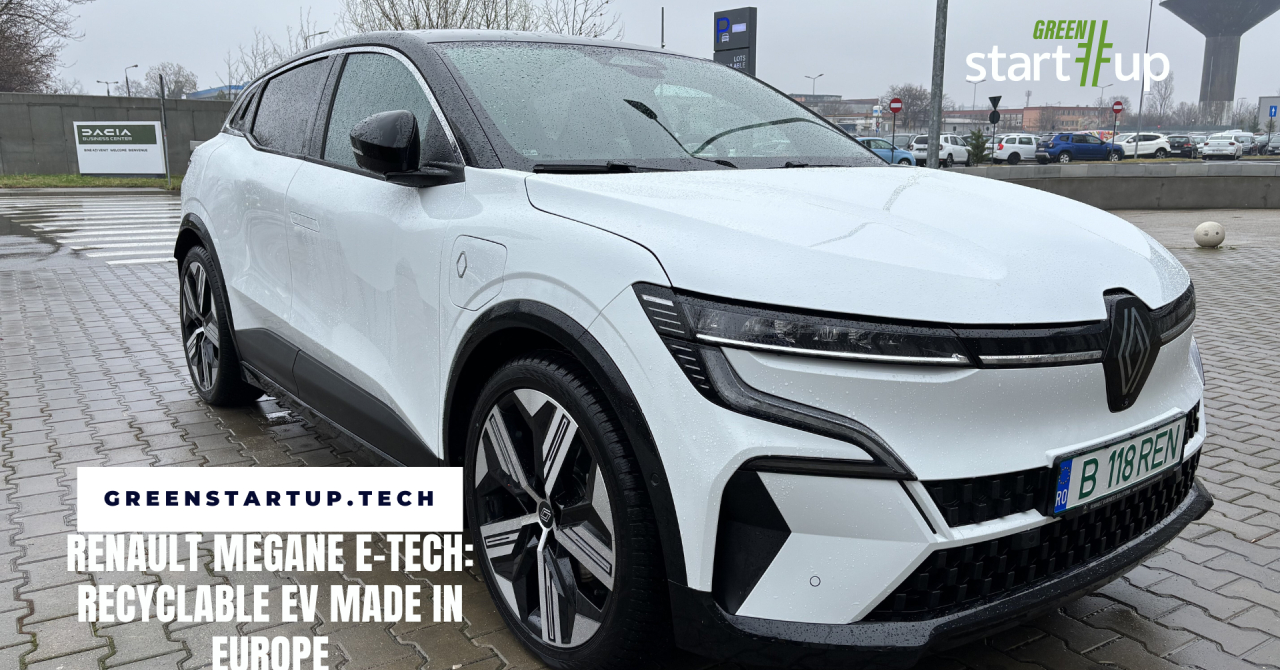What you'll learn from this test drive:
- How Renault optimized the production of the Megane E-Tech to establish a circular manufacturing process
- How the Megane E-Tech can be recycled almost completely
- How the technologies implemented within this EV can help you be a safer driver
We took the Megane E-Tech for a spin ourselves in its top end iconic variant, equipped with a heat pump and all the possible safety features that this model comes with. We will detail everything you need to know about the design of this car, how this fully electric model drives, what it offers on the software side and most importantly, how it sets a new standard for sustainability.
The design and quality of materials in the Megane E-Tech
The design part of any car is a subjective thing, but I personally like a lot the way French designers draw their cars, which is no different for the Megane E-Tech. The car is a fairly compact crossover, a little wider, but shorter.
What this means is that you'll be able to park it easily, so long as you are not constrained with the space on the sides, and the ground clearance of 13,5 cm will help you climb over moderate obstacles, if needed.
The chassis of the Megane E-Tech is made of aluminum, which is a light and durable metal. As per Renault officials, the designers and engineers of the company collaborated closely with the suppliers when making this vehicle to establish a closed loop for the aluminum used in production. Thus, the metal scraps that are left from the production are taken back to the supplier, who can recycle them and turn them into spare parts for the model.

On the inside, the Megane E-Tech uses even more recycled materials and what's more, these don't show in the quality of the build. "Inside, the Megane E-Tech Electric has 28 kg of recycled plastic in the dashboard, center console, seat covers and mats. This is one step further in the company’s endeavor to reduce its carbon footprint. Renault Group’s goal is 33% recycled materials in its vehicles by 2030", Renault explains.
This is not immediately obvious, since the Megane E-Tech appears to be a very modern car on the inside, well-built and spacious. The iconic version we had for testing comes with some extra visual features, which contribute to the premium feel of the car, such as wood elements on the front doors and the dash, as well as light leather on the seats, the armrest and all the door handles. There is synthetic dark leather on the dashboard of the vehicle, as well, and the steering wheel is also covered in leather.
What I can say is that when you get in this car you don't feel like the design would be too futuristic, but not excessively minimalist, as it is the case with some car manufacturers. It is overall very fitting and attractive, even if you opt for the base versions, which don't have as much leather.
Our car model was equipped with heated steering and front seats, as well as massage for the driver and the front occupant, and all worked very well. The seats are very comfortable, they are not the softest, but they offer great support when going around corners, but you will need to set them correctly, so that you have very good visibility and don't get tired.
You have enough space on the front and back, so long as you're not very tall and the driving position is not very high for a crossover, which I liked. You see very well to the front and to either side, the windows are large and there are no pillars in the way. In the back, the situation is not as good, since French designers put form over function and the Megane E-Tech doesn't offer the best visibility, but the good news is that the rear-view mirror has a digital version, which I'll talk about in a minute.

The boot space is a generous 440 liters, which can be expanded to over 1.300 if you fold the back seat. For such a compact model, the space is just as I expected and in line with what the competition offers.
The Megane E-Tech's main advantage is that the car is assembled in France and the production process has been optimized together with suppliers that are near the Douai factory. Thus, 70% of the components that make up the Megane Electric are from European suppliers, which contributes to the local and regional economy, as well as help reduce the carbon footprint.
Furthermore, Renault says that at the end of its life, over 90% of the Megane E-Tech can be recycled and starting this year, the batteries for the EV will also be manufactured in France, through a partnership with Envision AESC.
The driving experience in the Megane E-Tech
It's also important to talk about how this car drives, because depending on its version, it is comparable to the Volkswagen Id.3 or the base version of the Tesla Model 3.
First of all, the steering is very soft and the wheel can be turned to either side with very little effort. Even if it is a very heavy car, at around 1.7 tons and with 20-inch rims, the Megane E-Tech is very maneuverable and easy to drive in the city, which I think is the car's perfect environment.
The version we tested has a 220 HP engine and this is noticeable, as you can take off very smooth or very quickly, if you need it. I drove the car on comfort mode, but you can opt for eco, personalized or sport, depending on the situation. The multi-mode button on the steering can allow you to change between the driving modes rapidly.

The car pulls very well at any speed and you have to be careful, since you can easily find yourself above the legal speed limit in the city. Soundproofing is very good for the city environment, even with lots of traffic around or during rain, which can amplify noise.
The suspension is comfortable and I think is well-balanced between comfort and stability, also because the car's center of gravity is fairly low with the floor-mounted battery and the large and wide wheels. This makes the car very stable around corners, as well.
My only recommendation is that, if you're going to use the car for city driving mostly, to opt for the 18-inch rims, as they have a larger rubber area, which can help with shock absorption when taking a pothole or a speed bumper, for example, even though you might lose a bit on the efficiency side. Even with the larger 20-inch rims the ride is fairly smooth, but in a city like Bucharest, where the quality of the roads isn't the best, you might feel the bumps more than you would like to. If you drive more on the highway and express roads, then the 20-inch wheels will provide better resistance and thus, better efficiency.
When you take the foot off the accelerator, the Megane E-Tech can recover some of the energy through a simulated engine brake. You can select the intensity of this feature from the paddles located behind the steering, I opted for moderate regeneration while I had the car for testing.
The brakes are very good, you have ventilated discs at the front and back and the braking force is very good, especially taking into account how heavy the car is. The brakes will need some getting used to, as they work as soon as you pinch the pedal, but the intensity isn't very gradual and at some point, the Megane will apply braking pressure a bit too strong for my liking. This is something that you will get used to in time and the system will loosen up after a while.

I appreciate that Renault added auto hold on this vehicle and is a very useful feature when driving at low speeds with lots of stops between stoplights. You don't have to fully press the pedal to activate it, just around half is enough, when you will feel that the pedal will lower itself a little bit to let you know that the feature was activated.
The auto hold button is found on the left side of the steering on the dashboard, where you will also find the parking brake, which activates automatically when putting the vehicle in neutral.
The WLTP range of the Megane E-Tech is 470 kilometers for the model packing the 60kWh battery and the 220 HP motor and after around 20 kilometers of driving through a packed traffic an on two traffic-free boulevards, where I did some acceleration sprints, the battery dropped from 100 to 91%. The consumption recorded after a little over 20 kilometers was 23,4 kWh. This was achieved with the radio turned on, as well as with the heating turned to the first or second speed, accordingly.
Speaking of the heating system, the car can be equipped with a heat pump, which is great news not only for the thermal comfort, but for sustainability, as well, since it uses less power than a conventional air conditioning system.
Megane E-Tech can be had with a smaller 130 HP motor, as well as a 40kWh battery, which offers a lesser 300 kilometers of range, but all models offer DC charging at 130kW and 7KW at AC speeds. The optimum charge variant we had for testing upgrades the AC charging to 22kW.
Next, we'll move on the technologies packed in this car, which I feel are important and very well-done in this car.
Technologies and safety features on the Megane E-Tech
For the software side of the Megane E-Tech, Renault collaborated with Google and that is clear and a very good thing. Firstly, the multimedia system is comprised of a 12-inch openR link screen mounted vertically and the sound is coming from 9 Harman Kardon speakers, which sound excellent. I set the sound on the immersive mode with the subwoofer activated and listening to music on the system was a pleasure. You can choose between the other modes, studio, concert, lounge and club, while working with the equalizer if necessary.
Behind the steering there is another screen that has a few display modes, among which one with two indicators, for speed and other information, such as consumption, multimedia or the odometer. At the same time, you can choose to display the map on this screen, so that the 12-inch tablet is free for the passenger to play around with.

The menu on the 12-inch screen is very simple and similar to an older Android-powered phone. The operating system is indeed Android 10, with the security patch from 2022, although I hope further security updates are coming.
Otherwise, the system is very easy to use if you played around with Android phones with stock Google launchers in the past few years. You pull down from the top for the notification center, while at the top you have the information for battery, internet connection, Bluetooth, as well as the weather and time.
Below these elements are four quick commands for map, multimedia, phone, applications and the car's control center.
In the application menu I discovered a digital user's manual, shortcuts for Android Auto and Apple CarPlay, which work wirelessly, a device manager and Google Play store, where you can download additional apps that you might need. As I said, just like an Android phone, and from the Play Store I downloaded Spotify, which works very well on this car and looks very well though for a car application. You also have a calendar app, Google Assistant, the Maps app, Google News and Waze, for example.

The system is very fast in doing what you want it to do, it doesn't have any lag and the fact that it is based on a clean version of Android makes it easy to learn and the elements are well-spaced and visible.
The important part is for the vehicle's submenu, where you have access to all the car's features, listed clean and clear. By accessing the electric submenu, you have information about the battery and charging, a more detailed consumption, as well as driving scores, which adapts based on how you drive. I obtained 64, since I accelerated faster and I didn't always anticipate the traffic conditions ahead, but if you are driving in eco mode, for example, you will get a better rating.
There is a button which activates the 360 degrees camera and sensors system and optionally, you can add the automatic parking assistance pack, which adds another submenu that allows you to park the car autonomously in multiple positions, such as parallel parking.
You can also select a few options for the front seats, such as heating or massage, and you also have a separate menu for the air quality. On the model with a heat pump, you have the option for air purification and automatic air recycling, which is only available when selecting purification.
Driving and parking assistance includes functions that help increase the safety when driving the Megane E-Tech and among the options you have the ability to track the distance between the vehicle in the front, blind spot monitoring or driver monitor, which can detect when you are tired, for example. The car can also help you keep your lane and to put you back on the right track, if needed, and all these features can be turned on or off, although I left all of them turned on, since they greatly improve safety.

When parking the Megane E-Tech, the car can warn the passengers that open the doors without paying attention to incoming traffic and the car can even automatically brake if you're about to hit a car when reversing.
I promised to tell you about the rear-view mirror, which when pushed forward is in an analog format and you don't see too much of what's going on behind you, because of the small rear window. When you pull it towards you, however, you activate a rear camera, which helps you see better, but its position is a little weird and you will feel like those behind you are about to rear-end your car.
I recommend that you drive with the digital mirror enabled, since it offers much greater visibility and the brightness makes everything easily visible.
Renault Megane E-Tech conclusions
Renault Megane E-Tech has a starting price of 34.000 euros for the variant with the 130 HP motor and 40kWh battery, enough for city driving, while the top variant tested by us surpasses 45.000 euros.
At just over 40.000 euros you can buy the base version of the Volkswagen Id.3 or for 42.900 euros, the base version of the Tesla Model 3.
As far as I am concerned, the Megane E-Tech sits nicely between the two, because if you choose to spend a bit more than on the aforementioned models, you get the maxed-out version from Renault, which is more compact than either the VW or the Tesla, while delivering good range, sufficient space and power and you contribute to the promise of circular economy.
I think that the Megane E-Tech can be the ideal electric city crossover, being compact, easy to drive and park, with the fast charging enabling even long-distance driving, especially with the 60kWh battery.
I can see this being a very good family car, as well, if you have one or two kids, for example. You have a decent boot space, as well as plenty of space and comfort for a compact body, while the safety systems are in line with what you find at competitors.
Pros:
- compact, but spacious car
- good range and high DC charging speeds
- the top trim is slightly more expensive than the base versions from the competition
- recycled and recyclable materials
- Europe-made vehicle with locally-sourced components
Cons:
- reduced comfort with the 20-inch rims
- slow AC charging speeds without the optimum charge option (1.500 euros extra)
- small rear window and reduced visibility in the back without the digital mirror
 Mihai - Cristian Ioniță
Mihai - Cristian Ioniță












Any thoughts?